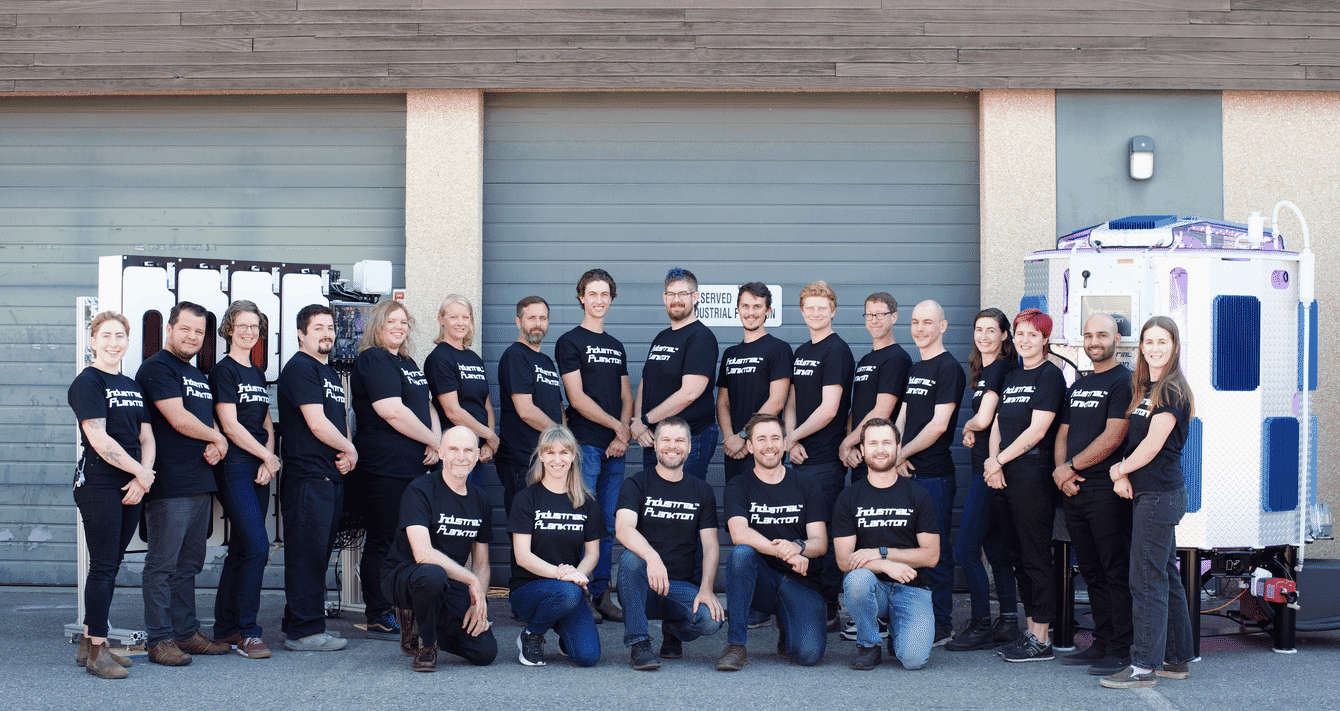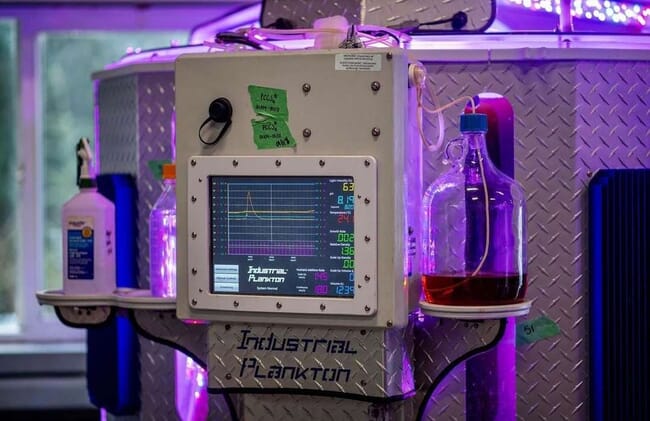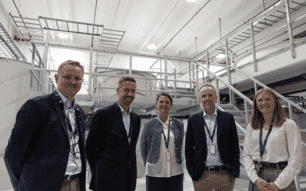
Robert Roulston (centre-front) and his team © Industrial Plankton
Can you tell me about your background and what inspired you to start a biotechnology company?
I did a biology degree, and during that I got obsessed with aquariums and fish. I just had aquariums everywhere in my room. After that I did a mechanical engineering degree, and I became obsessed with design.
I was breeding fish and propagating corals in my bedroom just to pay my rent and make a bit of money as a student. I always needed algae to feed the zooplankton, baby clownfish, and my corals, and I was having trouble growing it. I started to get really interested in the challenge of it. I started using everything I was learning in engineering to try to make an automated system for that. And that's where Industrial Plankton, what's now been a 14-year obsession, started. I still have the saltwater fish tank, so that's fun.
The first six years were really slow, and then the last six have been crazy. The scale up was when we started to learn about business and write up business plans. And then we started winning some business plan competitions, so we thought “we're smart, we know what we're doing,” but we were just children. We started raising little bits of money and making some progress and but nearly went bankrupt multiple times. We weren't cash flow positive till about six years ago. The first six years we just lost more and more money every year, but we were selling more. We turned the corner about 2018 and started being cash flow positive and we're up to 22 people in the company now.
Could you tell me about your technology and what makes it unique?
It's a closed bioreactor with a specially shaped tank. It's a really high surface area tank which lets you get much higher phytoplankton density than you would if it was just a large round tank. The light only penetrates about a centimetre into the tank when it's got a dense culture, so you're really only getting growth along that outer edge that's exposed to light. That's what is unique about our tanks, since you have other options for making high surface area with tubes or flat panels or that type of thing, but we have a large round tank with spikes that stick into it.
The other thing that makes it unique is how advanced the control system is. We've been working on that forever, and we do all our own circuit board and user interface design that's been obsessively improved over the years. It gets really nice real time feedback of all the environmental parameters inside the tank and lets you control anything with the push of a button, or you can programme in automation super easily. Once the machine's running you essentially don't have to touch it, just walk by with your coffee, make sure there's still CO2, make sure there's nutrients, and it will do all the harvesting and nutrient mixing and refilling for you.
You can also have it automatically scale up, where you put a little bit in to start and then it takes a week for it to scale up to full density - you can just have all that liquid addition and nutrient addition all programmed in so it happens without you even needing to be there.

Industrial Plankton uses a unique design to improve bioreactor performance © Industrial Plankton
How is your system applied for aquaculture?
More than half of our clients are shellfish hatcheries. So they were the earliest ones to start adopting our technology. We're in about fifty percent of the shellfish hatcheries in North America at this point, which is pretty crazy.
Over the last few years, shrimp hatcheries have actually started buying our technology as well. So we have sold to several shrimp hatcheries around the world. We’re really starting to open up that market, which is pretty exciting.
Are there any non-aquaculture applications?
That can be everything from medical opioids to bioactive fertilisers for agriculture, which is pretty interesting. It can also be used for pre-production for large biotech facilities. For example, somebody making Omega-3 can use our equipment to scale up their culture before putting it into their mass production systems. It can act like a mass inoculum generator for really large scale systems for industrial production.
Have you faced any competition in your market?
There are some other bioreactor companies operating, but most of them focus on the large scale whereas we have just focused on making something perfect for aquaculture. Instead of one large system, it's multiple systems so that there's redundancy there, which is really critical for hatcheries. With our system, you won't have your system go down and everything starve. For example, if one out of seven of your systems go down then you can get another one scaled back up before it matters. But really, I mean, at this point, I would say that about 99.9 percent of aquaculture is still done in a traditional way, not with some advanced photobioreactor like ours. Really the main competition is just the status quo.
The low-tech versions for shellfish hatcheries are often just simple bags of culture. Large hatcheries might have a warehouse of these bags, maybe even 200, and it's a tonne of labour, but they understand them and they work decently if you get a good operator. For the shrimp hatcheries, it's these large outdoor ponds - that's what you see all over the world for the shrimp hatcheries. Between those two traditional low-tech and high labour systems, that's the main competition.

Industrial plankton faces the challenge of overcoming conventional methods of algae production © Industrial Plankton
What challenges remain for the future?
Keeping up our growth is always a challenge. We've experienced 30 percent year over year growth for six years - that's what I'm most proud of, but it's also probably the challenge that still remains because you have to keep feeding the dragon and just getting more and more growth every year. And since it compounds, you know, that's doubling the company size every three years, roughly. We've doubled and then doubled again.
We’re four times bigger than we were six years ago now in terms of revenue and staff, so it's a challenge just keeping that scaling going because I don't want to plateau. And, you know, the bigger we are, the bigger impact we can have. I mean, I wouldn't mind getting rich, but it's mostly just the challenge of doing something good for the world. I'm a little obsessed with that.
How have you funded the business, and will you be looking for funding in the near future?
We raised money in the first six years, and we've raised a bit more money every year or year and a half. It just looked like a sawtooth that was getting bigger, bumping up and then back down to zero. We turned the corner around 2018 with our last raise, and we haven't raised money since. We're definitely exploring the option right now of raising some significant capital for an expansion. Now that we have a well-established foundation it looks like a good time. We could grow without it, but we could grow a lot faster with it.




